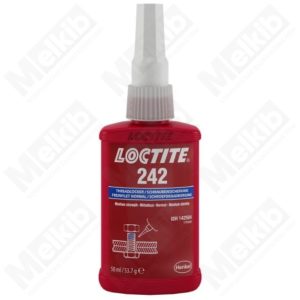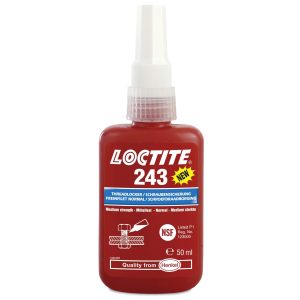Unlocking the Potential of Medium Strength Thread Locker: A Comprehensive Guide
Unlocking the Potential of Medium Strength Thread Locker: A Comprehensive Guide
In the realm of mechanical assemblies, ensuring the integrity and reliability of connections is paramount. Bolts, screws, and nuts are often the unsung heroes that hold structures together, whether it’s in automotive, aerospace, machinery, or everyday appliances. However, the forces of vibration, thermal expansion, and operational stresses can threaten the stability of these connections over time. To combat these challenges, engineers turn to thread lockers – adhesive compounds designed to secure threaded fasteners. Among the varieties available, medium strength thread locker stands out as a versatile and effective solution.
Understanding Medium Strength Thread Locker
Medium strength thread locker, often categorized as “Blue” thread locker due to its color, occupies a crucial middle ground between low and high strength variants. Unlike low strength thread lockers, which offer minimal resistance to vibrations and can be easily disassembled, and high strength variants, which provide a more permanent bond, medium strength thread locker strikes a balance. It offers a secure hold while still allowing for disassembly using standard hand tools when necessary.
Key Features and Benefits
- Vibration Resistance: Medium strength thread locker effectively prevents loosening of fasteners due to vibration, a common issue in machinery and automotive applications. By filling the gaps between threads, it creates a solid bond that maintains fastener integrity even under dynamic conditions.
- Corrosion Protection: Thread lockers not only secure fasteners but also seal out moisture and contaminants that can lead to corrosion. This is especially crucial in outdoor or high-humidity environments where metal components are prone to rust and degradation.
- Temperature Stability: Medium strength thread locker exhibits stable performance across a wide range of temperatures, making it suitable for applications exposed to varying thermal conditions. Whether in automotive engines subject to extreme heat or outdoor equipment enduring frigid temperatures, this thread locker maintains its efficacy.
- Removability: Unlike high strength thread lockers, which often require heat or specialized tools for disassembly, medium strength variants allow for easy removal using standard hand tools. This facilitates maintenance, repairs, and component replacement without the risk of damaging threads or fasteners.
- Versatility: Medium strength thread locker is compatible with a broad range of materials commonly used in manufacturing, including metals, plastics, and composites. This versatility makes it a go-to solution across diverse industries and applications.
Applications
The versatility and reliability of medium strength thread locker make it indispensable in numerous industries and applications, including:
- Automotive: Securing critical components such as engine mounts, suspension systems, and brake calipers.
- Aerospace: Fastening bolts and screws in aircraft structures, avionics, and propulsion systems.
- Manufacturing: Assembling machinery, equipment, and tools on production lines.
- Construction: Bolting structural elements, HVAC systems, and electrical fixtures.
- Consumer Electronics: Securing screws in appliances, gadgets, and electronic devices.
Best Practices for Application
To maximize the effectiveness of medium strength thread locker, it’s essential to adhere to best practices during application:
- Clean Surfaces: Ensure that mating surfaces are clean, dry, and free of oil, grease, or debris, which can compromise bonding.
- Apply Correctly: Follow manufacturer instructions for applying the thread locker, applying a small amount evenly to the threaded portion of the fastener.
- Allow Cure Time: Allow sufficient time for the thread locker to cure before subjecting the assembly to stress or load, typically 24 hours at room temperature.
- Use in Moderation: Avoid over-application of thread locker, as excess adhesive can seep out and cause contamination or interfere with assembly.
- Exercise Caution with Plastics: Some thread lockers may be incompatible with certain plastics, so it’s important to test compatibility or use alternative solutions if needed.
Loctite 242
Loctite 242LOCTITE® 242® is designed for the locking and sealing of threaded fasteners which require normal disassembly with standard hand tools. The product cures when confined in the absence of air between close fitting metal surfaces and prevents loosening and leakage from shock and vibration. Suitable for applications on less active substrates such as plated surfaces, where disassembly with hand tools is required for servicing. The thixotropic nature of LOCTITE® 242 ® reduces the migration of liquid product after application to the substrate.
Mil-S-46163A LOCTITE® 242® is tested to the lot requirements of Military Specification Mil-S-46163A. Note: This is a regional approval. Please contact your local Technical Service Center for more informationandclarification. ASTMD5363 Each lot of adhesive produced in North America is tested to the general requirements defined in paragraphs 5.1.1 and 5.1.2andtothe DetailRequirements definedin section 5.2.
LOCTITE 243
LOCTITE 243LOCTITE® 243™ is designed for the locking and sealing of threaded fasteners which require normal disassembly with standard hand toolsThe product cures when confined in the absence of air between close fitting metal surfaces and prevents loosening and leakage from shock and vibrationThe thixotropic nature of LOCTITE® 243™ reduces the migration of liquid product after application to the substrateLOCTITE® 243™ provides robust curing performance. It not only works on active metals (e.g. brass, copper) but also on passive substrates such as stainless steel and plated surfacesThe product offers high temperature performance and oil tolerance. It tolerates minor surface contaminations from various oils, suchascutting,lubrication,anti-corrosionandprotectionfluids
NSFInternational Registered to NSF Category P1 for use as a sealant where there is no possibilty of food contact in and around food processing areas. Note: This is a regional approval. Please contact your local Technical Service Center for more informationandclarification.
NSFInternational CertifiedtoANSI/NSFStandard61foruse in commercial and residential potable water systems not exceeding 82° C. Note: Thisisa regional approval. Please contact your local Technical ServiceCenterformoreinformationandclarification.
Conclusion
Medium strength thread locker plays a pivotal role in ensuring the reliability and longevity of mechanical assemblies across diverse industries. Its ability to provide a secure hold while allowing for disassembly when needed makes it a preferred choice for engineers and maintenance professionals alike. By understanding its features, benefits, applications, and best practices for use, manufacturers can harness the full potential of medium strength thread locker to enhance the performance and durability of their products and equipment.





